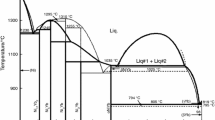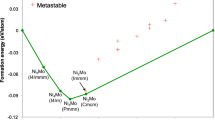Abstract
Calculations have given a consistent set of interaction constants for all the phases of variable composition in the Ni−Ru binary system, and also a set of stability constants for the ruthenium phases in its stable and virtual modifications. These data have been used to calculated a phase diagram for the Ni−Ru system. It is found that there is satisfactory agreement between the calculated phase diagram and the experimental one when one uses the subregular solution approximation for the solid and liquid phases of variable composition.
Similar content being viewed by others
References
T. A. Tumanova and N. G. Boriskina, “Corrosion resistance in hydrochloric acid for alloys in the titanium-ruthenium system,” in:Titanium Alloys with Special Properties [in Russian], Moscow (1982), pp. 127–130.
T. B. Massalski (ed.),Binary Alloy Phase Diagrams, in 2 Vols., ASM, Ohio (1986).
V. M. Danilenko, G. M. Lukashenko, and S. B. Prima, “Model description of phase equilibria in the Ti−Ni system,”Poroshk. Metall., No. 5, 70–75 (1991).
A. A. Ovcharenko, “Computing phase diagrams for certain binary alloys with the determination of interaction parameters from experimental phase diagrams,”Fiz. Met. Metalloved.,49(5), 1013–1020 (1980).
J. L. Murray, “The Ru−Ti system,”Bull. Alloy Phase Diagrams,3, No. 2, 216–221 (1982).
E. Raub and D. Menzel, “The nickel-ruthenium system,”Z. Metallkund.,52, 831–833 (1961).
I. I. Kornilov and K. P. Myasnikova, “The phase diagram and physical properties for alloys in the Ni−Ru system,”Izv. AN SSSR, Metallurgiya i Gornoe Delo,4, 159–165 (1964).
P. Nash, “The Ni−Ru system,”Bull. Alloy Phase Diagrams,7, No. 2, 130–133 (1986).
Metals Handbook: 8th Edition, Metallography, Strucutres and Phase Diagrams, Ohio (1973).
R. Hultgren, P. D. Desai, D. T. Hawkins, et al., “Selected values of the thermodynamic properties of the elements,”Amer. Soc. Met., Cleveland, Ohio (1973).
V. M. Danilenko, “Model phase description and phase-equilibrium calculations for binary and ternary systems based on transition metals,” in:Phase Stability and Phase Equilibria in Transition-Metal Alloys, V. N. Eremenko (ed) [in Russian], Nauk. Dumka, Kiev (1991), pp. 180–199.
V. M. Danilenko, S. V. Danilenko, T. G. Mazhuga, and E. L. Semenova, “Calculating phase equilibria for the Ti−Ru system,” in:Current Advances in Physical Metallography [in Russian], Inst. Probl. Materials Sci. Ukraine Nat. Acad. Sci., Kiev (1995), pp. 90–95.
L. Kaufman, and H. Bernstein,Computing Phase Diagrams [Russian translation], Mir, Moscow (1972).
Additional information
Institute for Problems of Materials Science, Ukraine National Academy of Sciences, Kiev. Translated from Poroshkovaya Metallurgiya, Nos. 5–6(407), pp. 48–55, May–June, 1999.
Rights and permissions
About this article
Cite this article
Danilenko, V.M., Velikanova, T.Y., Mazhuga, T.G. et al. Thermodynamic simulation of the Ni—Ru binary-system phase diagram. Powder Metall Met Ceram 38, 254–260 (1999). https://doi.org/10.1007/BF02675772
Received:
Issue Date:
DOI: https://doi.org/10.1007/BF02675772




